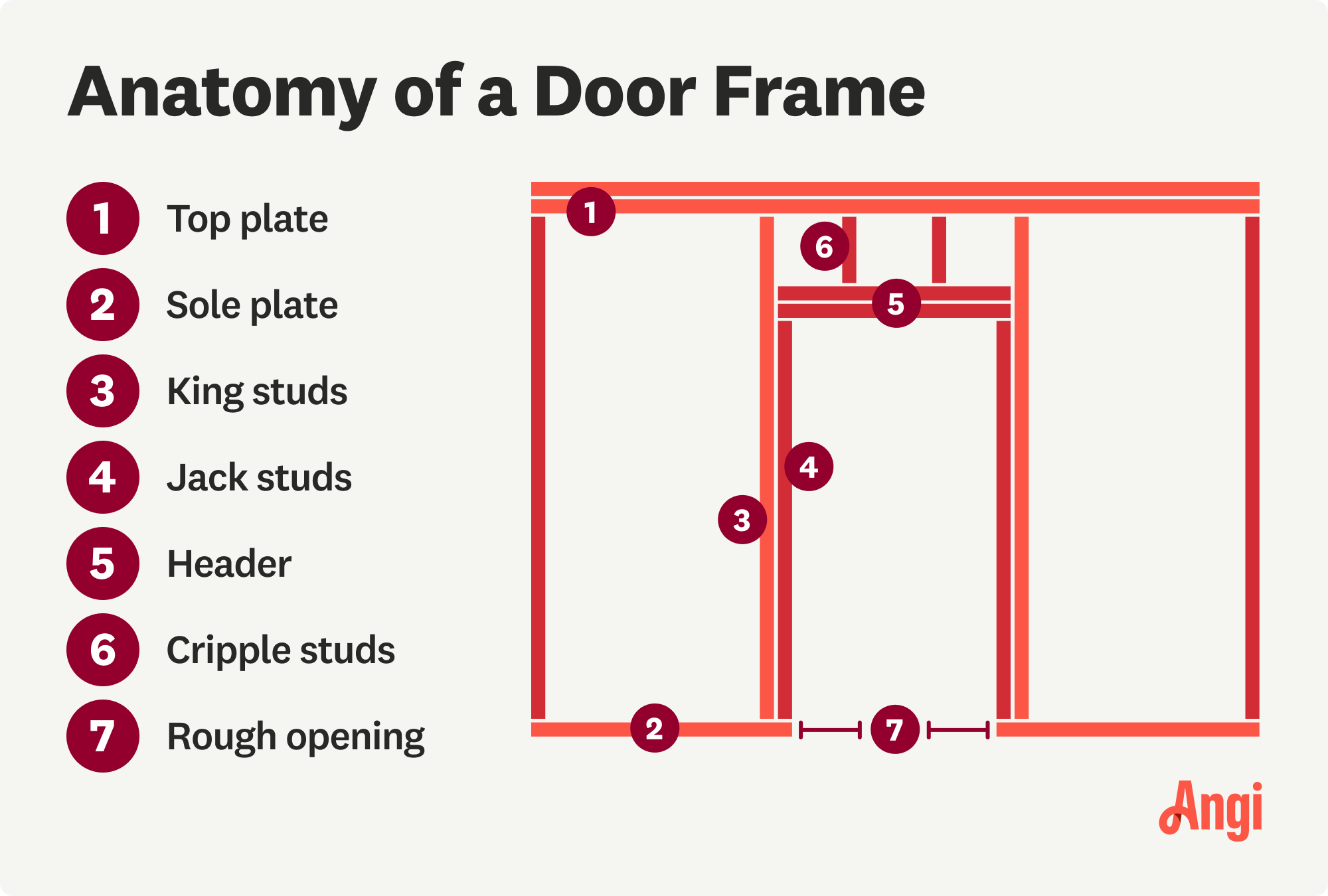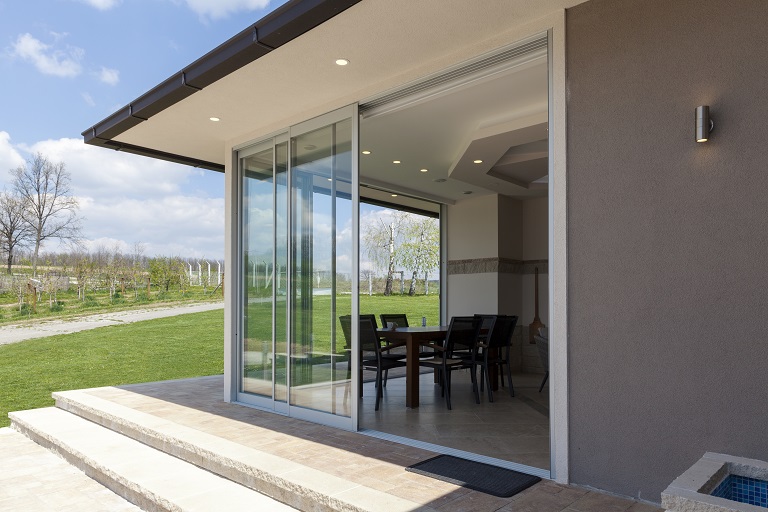
There’s nothing better than a dog door to give your pet free access to the outdoors. Use this dog door installation cost guide to see what it will cost you.
Time to get down to the studs


Without doors, your office would be too noisy, and your bathroom would lack privacy. Most homes have over a dozen doors, each kept in place by the door framing behind the drywall. Whether framing an interior door in an addition or placing a new door in an existing wall, this step-by-step guide will walk you through how to frame a door to ensure it’s supported properly and doesn’t compromise the structural stability of the wall around it.

This step-by-step process for how to frame a door assumes you want to install a pre-hung door on an interior wall with exposed framing. If you are adding a door to an existing wall, start by removing the existing drywall and any insulation to expose the framing.
When purchasing raw lumber to frame your door, you can choose from pine, alder, fir, or birch. These types of wood are suitable for interior framing—pine is the most popular and readily available, and it’s the most affordable, as well. The plywood you’ll buy will mostly act as a spacer, so you can save some money by buying the most affordable 1/2-inch sheet available. Just make sure you get real plywood and not MDF (medium-density fiberboard).
Some homeowners choose a variety of wood that matches the other areas of their homes, but because drywall will eventually cover your framing, aesthetics aren’t as important as sourcing quality, durable lumber.

Using a measuring tape, measure the width and height of your new door, including the frame. The standard door size for interior door frames is 80-by-32 inches, but the width can vary between 28 and 36 inches. Make sure you have the exact measurements of your particular door from edge to edge.
Next, add 2 inches to the width and 1 1/2 inches to the height measurement to determine your rough opening size. You’ll need this gap for the wooden shims you’ll use to level and install your pre-hung door.
The exact spacing will depend on the rough opening required for your particular door. If you purchased a new door, check the manufacturer’s instructions for the correct rough opening sizes.
Cut your top plate to size. After confirming the measurement, use nails or screws to secure it to the ceiling to create your upper horizontal framing. Top plates should only be installed through ceiling beams or blocking.
The sole plate is intended to be installed on the floor in alignment with the top plate. The top plate and sole plate should be the same exact width. Secure the sole plate to the floor joists or blocking using nails or screws.
With a pencil and a measuring tape, mark the rough opening width of your door frame on the sole plate, the framing member attached directly to your floor. On each side of your mark, measure 1 1/2 inches across and label the area “O” for the location of the jack stud. Next to the jack stud, measure another 1 1/2 inches across and label the area “X” for the king stud.
Then, locate the top plate—the framing near your ceiling that supports the roof or second floor. Once again, mark the rough opening width of your door frame on the board, ensuring it perfectly aligns with the mark on the sole plate. Repeat the steps above to mark the “O” and “X” locations. Double-check your markings by making sure each one on the top plate lines up with the marking on the sole plate.

Measure the distance between the sole plate and top plate at your king stud markings. This measurement will typically be 96 inches, which is the standard stud length. However, framing can shift, and imperfections in construction can lead to small differences. Measure just in case.
Using these measurements, cut two two-by-four lengths of lumber to fit this distance with a circular saw or miter saw. Position the board in place and check that it is plumb and in the right spot, according to your markings. This is the king stud, so it should sit on the “X” you marked.
Using a framing nailer and 3-inch nails, toenail the king studs into place, connecting each to the plate boards. Toenailing a board refers to driving in the nail at a 45-degree angle, which is necessary if you don’t have access to an already installed wall. If you’re framing your door before putting up the wall, nail the king studs from the top and bottom instead.
Next, prepare to install the jack studs directly next to the king studs, where previously marked with an “O” on the sole plate. Your jack studs should be the height of your rough opening, minus 1 1/2 inches, as they rest on top of the sole plate board. Cut these with your miter saw or circular saw as well.
Position the jack studs on the inside of the king studs and use your framing nailer to fix them into place, the same way you did for the king studs. Use a pair of nails every 12 inches to bond the boards together properly.

To build your door header, you’ll use two two-by-eight boards with a piece of plywood sandwiched in between. The thickness of the two-by-eight boards is 1 1/2 inches each, for a total of 3 inches. With the 1/2-inch plywood, you hit 3 1/2 inches, which matches the width of the two-by-fours you just installed for the jack studs and king studs.
Cut two two-by-eight boards to fit between your king studs and rest on top of your jack studs. If everything is plumb up to this point, the dimension should be your rough opening width, plus the depth of the two jack studs—or 3 inches. Cut a piece of 1/2-inch plywood the same length and width as your two-by-eight boards. Sandwich the plywood between the boards and connect all three pieces with framing nails.
Set your door header on top of the jack studs, with the face of the header lining up with the future face of the door. Connect your header to the king studs on each end with your framing nailer.
Cripple studs attach your door header to the above top plate to provide even support across the wall opening. Cut a pair of two-by-four boards to fit this distance and install them equally spaced apart. Check the level, then toenail the boards into the top plate on one end and the header on the other.
Now that your door is framed out, you can cut the sole plate board attached to your floor to open up the entire rough opening. Cut the sole plate where it meets the jack studs on each side using a reciprocating saw.
Your door frame is now complete. Next, you can set your interior door and finish off by installing drywall and installing door casing.
Professional door installers should ideally handle this high-stakes, potentially load-bearing project unless you have a high level of DIY or contracting experience. On average, the cost to have a door professionally framed is between $200 and $650 per door opening. Meanwhile, the cost for lumber and nails for a DIY door frame can be as low as $80 to $100.
Calling an expert comes with the peace of mind of knowing that all work will be up to code. What's more, a pro will help you avoid the risk of experiencing a wall collapse if you're installing a door frame within a load-bearing wall.
Based on data from Angi, 52% of homeowners need additional carpentry work when repairing a door jamb. If you’re not sure if you need more work, you’re not alone, as another 23% of homeowners wanted a recommendation from a professional.
From average costs to expert advice, get all the answers you need to get your job done.

There’s nothing better than a dog door to give your pet free access to the outdoors. Use this dog door installation cost guide to see what it will cost you.

Are you looking to upgrade an old door in your home? Use this interior door installation cost guide to estimate the project's total cost and learn how to save.

The frame is a crucial part of a door’s looks and proper functioning. Here’s how much you can expect to pay to replace a door frame in your home.

If you’ve ever wondered, “What is a fire door, and do I need one?” check out our all-encompassing guide on fire doors and their pros and cons.

Learn how to quickly soundproof your interior doors and keep unwanted noise out with a little weatherstripping and time.

Get expert insights on sliding glass door repair cost, including average prices, key cost factors, and tips to save money on your next repair project.